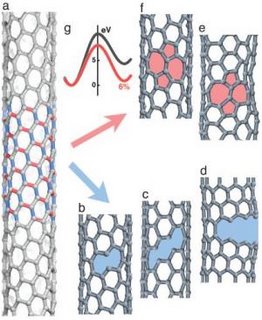
In theory, carbon nanotubes are 100 times stronger than steel, but in practice, scientists have struggled make nanotubes that live up to those predictions, in part, because there are still many unanswered questions about how nanotubes break and under what conditions.
Because nanotubes are single molecules - about 80,000 times smaller than a human hair - finding out what makes them break involves the study of molecular bonds, atomic dynamics and complex quantum phenomena. The fact that there are hundreds of different kinds of nanotubes, sometimes with radically different properties, adds to the complexity.
Because nanotubes are single molecules - about 80,000 times smaller than a human hair - finding out what makes them break involves the study of molecular bonds, atomic dynamics and complex quantum phenomena. The fact that there are hundreds of different kinds of nanotubes, sometimes with radically different properties, adds to the complexity.
A new computer modeling approach developed by materials scientists at Rice University is allowing researchers to create a "strength map" that plots the likelihood or probability that a nanotube will break - and how it's likely to break - based on four key variables.
"Nanotubes break in one of two ways: the bonds either snap in a brittle fashion or they stretch and deform," said Boris Yakobson, professor of mechanical engineering, materials science and chemistry. "We found that the underlying mechanisms that cause both types of breaks are each present at the same time. Even in a particular test, either type of break can occur, but we were able to map out a pattern - based on statistical probabilities - of what was likely to occur in a range of conditions for the whole catalog of nanotube species."
There is an available source where this information is completed and synthesized:
Gould, Paula. "Model maps nanotube stregth." Materials Today . (2006): v.9, 13.
You can find it at: http://www.materialstoday.com/2006_issues/june.htm
Copyright Photograph by Roland Piquepaille.
(I'm so happy, finally I'm signed in)

No hay comentarios.:
Publicar un comentario